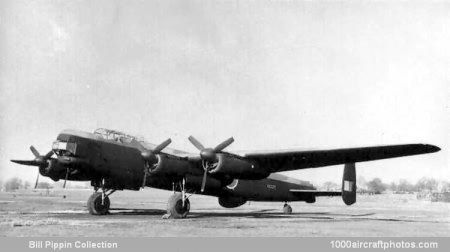The Lincoln was designed to Spec. B. 14/43, and was originally known as the Lancaster B.Mk.IV and B.Mk.V. It followed the well-proven Lancaster formula, but with wings of higher aspect ratio, lengthened fuselage and more powerful 1,750 hp Rolls-Royce Merlin 85s. The prototype (PW 925) flew at Ringway on June 9, 1944 without armament. Later it was fitted with a Martin dorsal turret, but the next three prototypes and all production aircraft had a Bristol dorsal turret. By 1955 most remaining Lincolns were flying without a dorsal turret.
The Lincoln B.Mk.I carried a crew of seven and an armament of twin 0.50 in (12.7 mm) guns in each of nose, dorsal and tail turrets. Some with twin 0.787 in (20 mm) guns in dorsal turret and single 0.50 in (12.7 mm) ventral gun. Maximum bomb-load was 14,000 lb (6,350kg). Production versions of the Lincoln (commencing with s/n RA615) were the B.Mk.I (Merlin 85) and B.Mk.II (Merlin 66, 68A or 300), the B.Mk.IV being a B.Mk.II converted to take Merlin 85s.
In November 1945 contracts for 800 were in hand, however, Avro built only 168, ending with s/n RE424 on April 24, 1946. In addition, 281 were built by Armstrong Whitworth ending with s/n WD149 which was delivered in March 1951. The first Lincolns entered service with No. 57 Squadron at East Kirkby in 1945, and were preparing to join Tiger Force to bomb Japan when VJ-Day arrived.
Although rapidly outmoded for modern warfare, the Lincolns proved useful weapons for operations against the terrorists in Malaya and in the war against the Mau-Mau in Kenya. The Lincoln was the last piston-engined bomber of the RAF, and with its retirement Bomber Command became an all-jet force.
Span: 120 ft 0 in (36.58 m)
Length: 78 ft 3.5 in (23.86 m)
Height: 17 ft 3.5 in (5.27 m)
Wing area: 1,421 sq.ft (132.02 sq.m)
Weight empty: 43,400 lb (19,686 kg)
Loaded weight: 75,000 lb (34,019 kg)
Max speed: 319 mph (513 kmh) at 18,500 ft (5,639 m)
Cruise speed: 215 mph (346 kmh) at 20,000 ft (6,096 m)
Climb: 800 ft (244 m)/min
Service ceiling: 30,500 ft (9,296 m)
Range: 2,930 mls (4,715 km)
